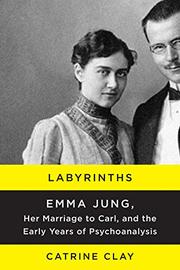

LABYRINTHS
Emma Jung, Her Marriage to Carl, and the Early Years of Psychoanalysis
by Catrine Clay
The making of two psychoanalysts: Carl Jung and his loyal, ever supportive wife.
When she was 17, Emma Rauschenbach, the quiet, shy daughter of an “unimaginably wealthy” Swiss business magnate, met the impoverished medical student Carl Jung (1875-1961). Already engaged to a young man from her own class, she refused Jung’s first proposal of marriage. But eventually, encouraged by her mother, she was won over by her handsome, intelligent, boisterous, and persistent suitor. Award-winning documentary producer Clay (Trautmann’s Journey: From Hitler Youth to FA Cup Legend, 2010, etc.) tries to push Emma to the center of this sympathetic, carefully researched biography, but Emma’s volatile, difficult husband intrudes, resulting in a portrait of a troubled marriage and the rivalrous beginnings of psychoanalysis. Clay diagnoses Jung’s neurosis as a kind of split personality: a “loud, opinionated, energetic Steam-Roller” Personality 1 alternated with Personality 2, a depressed, neurotic, “inferior wretch” who flew into inexplicable rages; withdrew from family life (the Jungs had five children); and was haunted by disturbing dreams. Confronting her husband’s dramatic mood swings was one challenge for Emma; another was his conviction that infidelity was a requirement for a good marriage. Clay chronicles many “infatuations,” including notorious liaisons with two deeply unstable patients: Sabina Spielrein and Toni Wolff. Wolff came to live with the Jungs, with Emma’s acquiescence, serving as Carl’s “anima figure.” Spielrein, Wolff, and Emma herself became analysts, demonstrating the fluid nature of professionalism in early psychoanalysis. Clay maintains that Emma’s close involvement in her husband’s work provided her analytical training. As is well-known, Freud first considered Jung to be his heir, but Jung came to reject Freud’s views and, to Emma’s dismay, broke off their relationship. “So we are rid of them at last,” Freud wrote to a colleague, “the brutal holy Jung and his pious parrots.” Emma forged her own friendship with Freud, often sharing her analysis of her husband and herself.
A sensitive biography of a woman whose emotional and intellectual strengths were the ballast of her marriage and family.